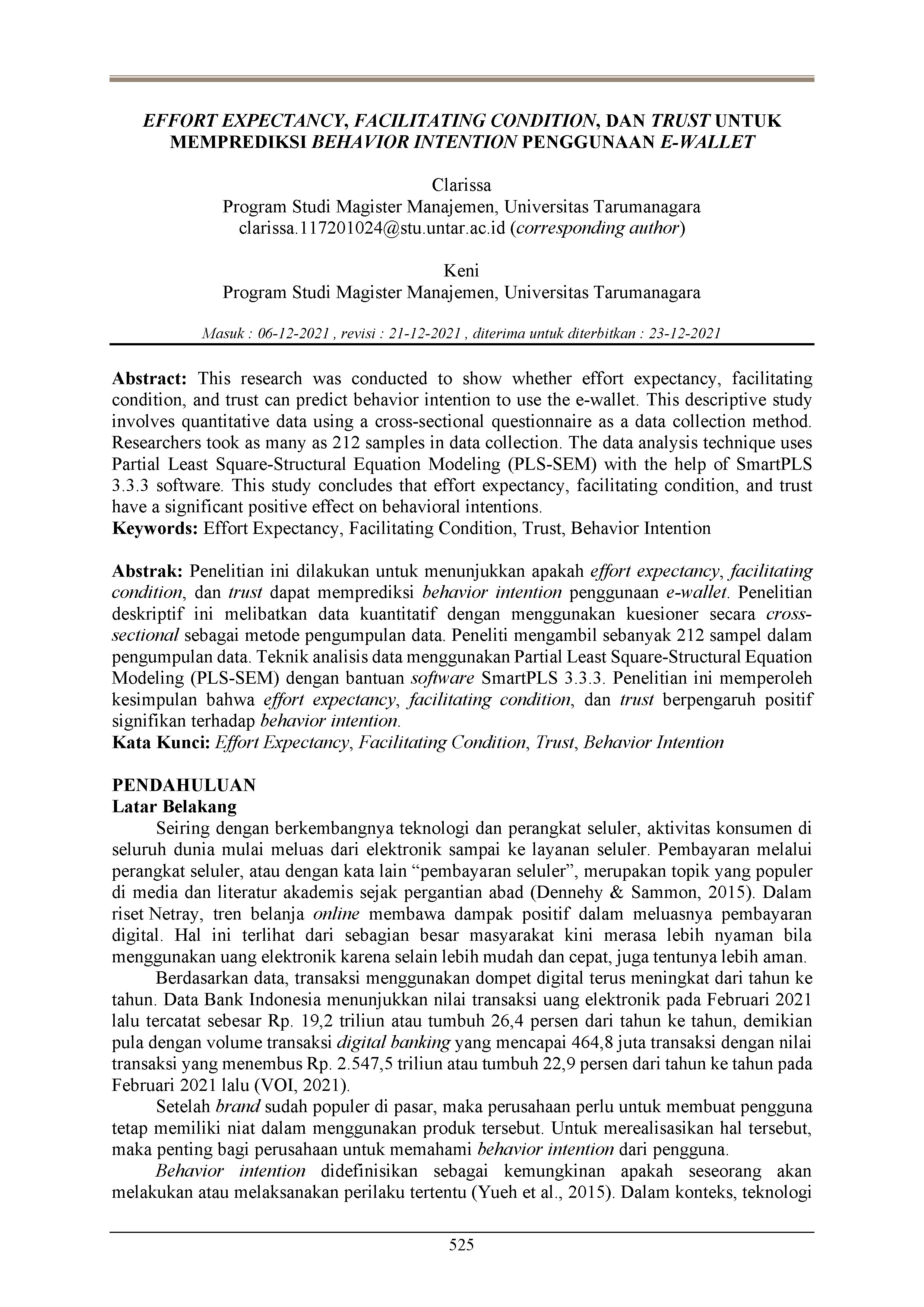Effort Expectancy, Facilitating Condition, dan Trust untuk Memprediksi Behavior Intention Penggunaan e-Wallet
Main Article Content
Abstract
This research was conducted to show whether effort expectancy, facilitating condition, and trust can predict behavior intention to use the e-wallet. This descriptive study involves quantitative data using a cross-sectional questionnaire as a data collection method. Researchers took as many as 212 samples in data collection. The data analysis technique uses Partial Least Square-Structural Equation Modeling (PLS-SEM) with the help of SmartPLS 3.3.3 software. This study concludes that effort expectancy, facilitating condition, and trust have a significant positive effect on behavioral intentions.
Penelitian ini dilakukan untuk menunjukkan apakah effort expectancy, facilitating condition, dan trust dapat memprediksi behavior intention penggunaan e-wallet. Penelitian deskriptif ini melibatkan data kuantitatif dengan menggunakan kuesioner secara cross-sectional sebagai metode pengumpulan data. Peneliti mengambil sebanyak 212 sampel dalam pengumpulan data. Teknik analisis data menggunakan Partial Least Square-Structural Equation Modeling (PLS-SEM) dengan bantuan software SmartPLS 3.3.3. Penelitian ini memperoleh kesimpulan bahwa effort expectancy, facilitating condition, dan trust berpengaruh positif signifikan terhadap behavior intention.
Article Details

This work is licensed under a Creative Commons Attribution-NonCommercial-ShareAlike 4.0 International License.
This work is licensed under a Jurnal Manajemen Bisnis dan Kewirausahaan Creative Commons Attribution-ShareAlike 4.0 International License.
References
Abrahão, R. de S., Moriguchi, S. N., & Andrade, D. F. (2016). Intention of adoption of mobile payment: An analysis in the light of the unified theory of acceptance and use of technology (UTAUT). RAI Revista de Administração e Inovação, 13(3), 221–230. https://doi.org/10.1016/j.rai.2016.06.003
Aksoy, Y., Basso, H. S., Smith, R. P., & Grasl, T. (2019). Demographic structure and macroeconomic trends. American Economic Journal: Macroeconomics, 11(1), 193–222. https://doi.org/10.1257/mac.20170114
Celik, H. (2016). Customer online shopping anxiety within the unified theory of acceptance and use technology (UTAUT) framework. Asia Pacific Journal of Marketing and Logistics, 28(2), 278–307. https://doi.org/10.1108/APJML-05-2015-0077
Dennehy, D., & Sammon, D. (2015). Trends in mobile payments research: A literature review. Journal of Innovation Management, 3(1), 49–61. https://doi.org/10.24840/2183-0606_003.001_0006
Eisingerich, A. B., & Bell, S. J. (2008). Perceived service quality and customer trust: Does enhancing customers’ service knowledge matter? Journal of Service Research, 10(3), 256–268. https://doi.org/10.1177/1094670507310769
Everard, A., & Galletta, D. F. (2005). How presentation flaws affect perceived site quality, trust, and intention to purchase from an online store. Journal of Management Information Systems, 22(3), 56–95. https://doi.org/10.2753/mis0742-1222220303
Gupta, K. P., Manrai, R., & Goel, U. (2019). Factors influencing adoption of payments banks by Indian customers: extending UTAUT with perceived credibility. Journal of Asia Business Studies, 13(2), 173–195. https://doi.org/10.1108/JABS-07-2017-0111
Keong, M. L., Ramayah, T., Kurnia, S., & Chiun, L. M. (2012). Explaining intention to use an enterprise resource planning (ERP) system: An extension of the UTAUT model. Business Strategy Series, 13(4), 173–180. https://doi.org/10.1108/17515631211246249
Kim, T. (Terry), Kim, W. G., & Kim, H. B. (2009). The effects of perceived justice on recovery satisfaction, trust, word-of-mouth, and revisit intention in upscale hotels. Tourism Management, 30(1), 51–62. https://doi.org/10.1016/j.tourman.2008.04.003
Kwateng, K. O., Atiemo, K. A. O., & Appiah, C. (2019). Acceptance and use of mobile banking: An application of UTAUT2. Journal of Enterprise Information Management, 32(1), 118–151. https://doi.org/10.1108/JEIM-03-2018-0055
Lien, C. H., Wen, M. J., Huang, L. C., & Wu, K. L. (2015). Online hotel booking: The effects of brand image, price, trust and value on purchase intentions. Asia Pacific Management Review, 20(4), 210–218. https://doi.org/10.1016/j.apmrv.2015.03.005
Miltgen, C. L., Popovič, A., & Oliveira, T. (2013). Determinants of end-user acceptance of biometrics: Integrating the “Big 3” of technology acceptance with privacy context. Decision Support Systems, 56(1), 103–114. https://doi.org/10.1016/j.dss.2013.05.010
Pikkarainen, T., Pikkarainen, K., Karjaluoto, H., & Pahnila, S. (2004). Consumer acceptance of online banking: An extension of the technology acceptance model. Internet Research, 14(3), 224–235. https://doi.org/10.1108/10662240410542652
Plouffe, C. R., Vandenbosch, M., & Hulland, J. (2001). Intermediating technologies and multi-group adoption: A comparison of consumer and merchant adoption intentions toward a new electronic payment system. Journal of Product Innovation Management, 18(2), 65–81. https://doi.org/10.1111/1540-5885.1820065
Shao, Z., Zhang, L., Li, X., & Guo, Y. (2019). Antecedents of trust and continuance intention in mobile payment platforms: The moderating effect of gender. Electronic Commerce Research and Applications, 33, 100823. https://doi.org/10.1016/j.elerap.2018.100823
Venkatesh, V., & Davis, F. D. (2000). A theoretical extension of the technology acceptance model: Four longitudinal field studies. Management Science, 46(2), 186–204. https://doi.org/10.1287/mnsc.46.2.186.11926
Venkatesh, V., Morris, M. G., Davis, G. B., & Davis, F. D. (2003). User acceptance of information technology: Toward a unified view. MIS Quarterly: Management Information Systems, 27(3), 425–478. https://doi.org/10.2307/30036540
Venkatesh, V., Thong, J. Y. L., & Xu, X. (2012). Consumer acceptance and use of information technology: Extending the unified theory of acceptance and use of technology. MIS Quarterly: Management Information Systems, 36(1), 157–178. https://doi.org/10.2307/41410412
VOI. (2021). Persaingan sengit dompet digital, siapa terdepan? VOI. https://voi.id/en/technology/42950/persaingan-sengit-dompet-digital-siapa-terdepan
Yueh, H. P., Huang, J. Y., & Chang, C. (2015). Exploring factors affecting students’ continued Wiki use for individual and collaborative learning: An extended UTAUT perspective. Australasian Journal of Educational Technology, 31(1), 16–31. https://doi.org/10.14742/ajet.170


